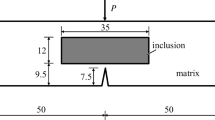Abstract
Weight functions proposed for interface cracks in dissimilar isotropic materials (Gao, 1991; Chen and Hasebe, 1994) are extended to treat those in piezoelectric materials. The difficulties in separating the eight distinct complex arguments are overcome. The pseudo-orthogonal properties of the eigenfunction expansion form found in isotropic dissimilar cases(Chen and Hasebe, 1994) are proved to be valid in the present cases although the mathematical manipulations performed here seem much more complicated than those in isotropic dissimilar materials. Several path-independent integrals are obtained and all the coefficients in the eigenfunction expansion form, including the K I, K II, K III and K e, could be calculated by the weight functions introduced in this paper. It is concluded that the weight functions presented here provide a powerful tool to calculate the dominant parameters at the interface crack tip without any special treatment to the singular stress field of the near-tip region.
Similar content being viewed by others
References
Beom, H.G. and Atluri, S.N. (1996). Near-tip fields and intensity factors for interfacial cracks in dissimilar anisotropic media. International Journal of Fracture 75, 163–183.
Bueckner, H.F. (1973). Field singularities and related integral representations. Mechanics of Fracture 1, 239–314.
Bueckner, H.F. (1987). International Journal of Solids and Structures 23, 57.
Chen, Y.Z. (1985). New path independent integrals in linear elastic fracture mechanics. Engineering of Fracture Mechanics 22, 673–686.
Chen, Y.Z. (1989). Weight function technique in a more general case. Engineering of Fracture Mechanics 33, 983–986.
Chen, Y.Z. and Hasebe, N. (1994). Eigenfunction expansion and higher order weight functions of interface cracks. Journal of Applied Mechanics 61, 843–849.
Chung, M.Y. and Ting, T.C.T. (1996). Piezoelectric solid with an elliptic inclusion or hole. International Journal of Solids and Structures 33, 3343–3361.
Deng, W. and Meguid, S.A. (1998). Analysis of conducting rigid inclusion at the interface of two dissimilar piezoelectric materials. Journal of Applied Mechanics 65, 76–84.
Gao, H. (1991). Weight function analysis of interface crack: mismach versus oscillation. Journal of Applied Mechanics 58, 931–938.
Gao, H. (1992). Weight function method for interface cracks in anisotropic bimaterials. International Journal of Fracture 56, 138–158.
Gao, H. and Rice, J.R. (1986). Shear stress intensity factors for a planar crack with slightly curved front. Journal of Applied Mechanics 53, 774–778.
Gao, H. and Barnett, D.M. (1996). An invariance property of local energy release rate in a strip saturation model of piezoelectric fracture. International Journal of Fracture 79, R25–R29.
Gao, H., Zhang, T.-Y. and Tong, P. (1997). Local and global energy release rates for an electrically yielded crack in a piezoelectric ceramic. Journal of the Mechanics and Physics of Solids 45, 491–510.
Hong, C. and Stern, M. (1978). The computation of stress intensity factors in dissimilar materials. Journal of Elasticity 8, 21–34.
Pak, Y.E. (1990). Crack extension force in a piezoelectric material. Journal of Applied Mechanics 57, 863–869.
Park, S.B. and Sun, C.T. (1995a). Fracture criteria for piezoelectric ceramics. Journal of the American Ceramic Society 78, 1475–1480.
Park, S.B. and Sun, C.T. (1995b). Effect of electric fields on fracture of piezoelectric ceramics. International Journal of Fracture 70, 203–216.
Qu, J. and Li, Q. (1991). Interfacial dislocation and its applications to interface cracks in anisotropic bimaterials. Journal of Elasticity 26, 169–195.
Rice, J.R. (1972). Some remark on elastic crack tip stress fields. International Journal of Solids and Structures 8, 751–758.
Rice, J.R. (1985). First-order variation in elastic fields due to variation in location of a planar crack front. Journal of Applied Mechanics 52, 571–579.
Rice, J.R. (1988). Elastic fracture mechanics concept for interfacial cracks. Journal of Applied Mechanics 55, 98–103
Sham, T.L. (1989). The theory of higher order weight functions for linear elastic plane problems. International Journal of Solids and Structures 25, 357–380.
Sham, T.L. and Zhou, Y. (1989). Weight function in two-dimensional bodies with arbitrary anisotropy. International Journal of Fracture 40, 13–41.
Sosa, H.A. (1991). Plane problems in piezoelectric media with defects. International Journal of Solids and Structures 28, 491–505.
Sosa, H.A. (1992). On the fracturemechanics of piezoelectric solids. International Journal of Solids and Structures 29, 2613–2622.
Sosa, H.A. and Pak, Y.E. (1990). Three dimensional eigenfunction analysis of a crack in a piezoelectric materials. International Journal of Solids and Structures 26, 1–15.
Stern, M. (1979). The numerical calculation of thermally induced stress intensity factors. Journal of Elasticity 9, 91–95.
Suo, Z., Kuo, C.M., Barnett, D.M. and Willis, J.R. (1992). Fracture mechanics for piezoelectric ceramics. Journal of the Mechanics and Physics of Solids 40, 739–765.
Ting, T.C.T. (1986). Explicit solution and invariance of the singularities at an interface crack in anisotropic composites. International Journal of Solids and Structures 22, 965–983.
Wu, K.C. (1990). Stress intensity factor and energy release rate for interfacial cracks between dissimilar anisotropic material. Journal of Applied Mechanics 57, 882–886333.
Author information
Authors and Affiliations
Rights and permissions
About this article
Cite this article
Ma, LF., Chen, YH. Weight functions for interface cracks in dissimilar anisotropic piezoelectric materials. International Journal of Fracture 110, 263–279 (2001). https://doi.org/10.1023/A:1010805704212
Issue Date:
DOI: https://doi.org/10.1023/A:1010805704212




